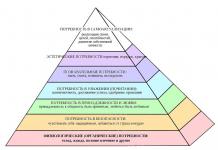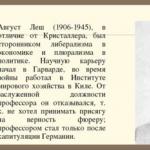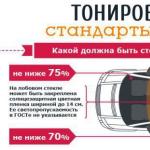The problem of man is the central problem of social science.
There are different concepts of human origins. The earliest is theological (religious), which gives a person a soul - a manifestation of the divine, which makes a person human. The natural science concept put forward by Charles Darwin in his work “The Descent of Man and Sexual Selection” puts forward a hypothesis about the origin of man from animals in the process of evolution. This theory is developed by F. Engels in his work “The Role of Labor in the Transformation of Ape into Man.”
The research of Louis Pasteur, who proved the impossibility of the spontaneous generation of life, led to new searches. As a result, the paleovisit theory emerged, i.e. extraterrestrial origin of life.
At the moment, the main one is the natural science concept, on the basis of which the concept of the biosocial nature of man was born.
Man by nature is biosocial being, since at the same time it is a part of nature and, at the same time, inextricably linked with society.
Biological nature of a person is manifested in his anatomy, physiology, genome, which is the carrier of hereditary information. The biological influences the processes of childbirth, the overall life expectancy of a person and also affects the development of some of his abilities - forms of reaction to the outside world.
Under social in a person they understand such properties as consciousness and reason, the ability to act practically, freedom and responsibility, citizenship, etc.
In resolving the issue of the relationship between the biological and the social in a person, two extreme positions have emerged: biologizing and sociologizing.
A common feature of biologizing concepts is the interpretation of the essence of man primarily from the standpoint of biology. Their representatives strive to explain human social actions by his biological and genetic characteristics and see the key to understanding humans in molecular genetics.
Sociologizing concepts absolutize the meaning of social relations. Representatives of this movement believe that all people are born with the same genetic inclinations, and society plays the main role in the development of their abilities. This understanding of man was widespread among supporters of Marxism.
Most scientists in solving the biosocial problem tend to avoid extremes and consider man as a complex synthesis, an interweaving of biological and social principles. They believe that a born child is a biological living system that does not yet possess thinking and speech. Its physiological organization only has the potential, under certain social conditions, to realize the ability to think and speak. However, it is emphasized that qualities such as the ability to think and act practically have a social origin.
To study human essence in philosophy, there is a variety of concepts, the most important of which are man, individual, individuality, personality. These concepts characterize an individual from various aspects.
Concept Human reflects common features (biological organization, consciousness, language, ability to work) inherent in the entire human race. This concept emphasizes the presence in the world of such a special historically developing community as the human race, humanity, which differs from all other material systems only in its inherent way of life.
Concept individual denotes a person as a single representative of the human race. This is a generalized image of a specific person. The concept of an individual does not capture any special properties of a person.
Concept individuality characterizes the originality, uniqueness, originality of the individual. Each person has a biological and socio-psychological individuality (temperament, abilities)
Capabilities– mental properties that are conditions for the successful performance of one or more activities.
There are abilities general (intellectual) and special.
Ability Levels:
Makings – congenital physiological characteristics (for example, the visual analyzer of the brain is more developed than average)
Giftedness – integral level of development of special abilities (artistic talent)
Talent is a set of abilities that develops as a result of activity, allowing one to obtain a special, unique product of activity.
Genius– the highest degree of development of abilities, the ability to create a qualitatively new creation.
In concept personality has an even narrower meaning. Personality is an individual taken in the aspect of his social qualities (views, abilities, moral beliefs, etc.). The concept of “personality” reflects everything socially significant in a person.
Internal personality structure:
1. Temperament. Determined genetically. There are four types of temperament: phlegmatic (psychological stability, balance and perseverance in achieving goals); choleric (unbalanced, superficial person); sanguine (impressionable, fast, persistent, but only when he is interested); melancholic (impressionable, constantly analyzes and criticizes himself).
2. Character. Translated from Greek, “character” is “minting”, “sign”. Indeed, character is the special characteristics that a person acquires while living in society. Just as the individuality of a person is manifested in the peculiarities of mental processes (good memory, rich imagination, intelligence, etc.) and in temperamental traits, it also reveals itself in character traits.
Character is a set of stable individual characteristics of a person that develops and manifests itself in activity and communication, determining the individual’s typical modes of behavior.
Character is determined and formed throughout a person’s life. The way of life includes the way of thoughts, feelings, motives, actions in their unity. Therefore, as a certain way of life of a person is formed, the person himself is formed. A big role here is played by social conditions and specific life circumstances in which a person’s life path takes place.
Any character trait is some stable stereotype of behavior. However, character traits cannot be taken out of the typical situations in which they appear; in some situations, even a polite person can be rude. Therefore, any character trait is a stable form of behavior in connection with specific situations typical for a given type of behavior.
A character trait includes a certain way of thinking and understanding. When committing a characteristic act, volitional mechanisms are activated and feelings are involved.
The formation of character traits cannot be separated from the formation of behavioral motives. Motives of behavior, realized in action, consolidated in it, are fixed in character. The path to the formation of character traits lies, therefore, through the formation of appropriate motives of behavior and the organization of actions aimed at consolidating them.
The most common character traits are arranged along the axes:
strength - weakness;
hardness - softness;
integrity - inconsistency;
breadth - narrowness.
If strength of character is understood as the energy with which a person pursues his goals, his ability to become passionately carried away and develop great tension when encountering difficulties, the ability to overcome them, then weakness of character is associated with the manifestation of cowardice, indecisiveness in achieving goals, instability of views, etc. .d.
A person’s character is manifested in a system of relationships:
In relation to other people (in this case, one can highlight such character traits as sociability - isolation, truthfulness - deceit, tactfulness - rudeness, etc.);
In relation to business (responsibility - dishonesty, hard work - laziness, etc.);
In relation to oneself (modesty - narcissism, self-criticism - self-confidence, etc.);
In relation to property (generosity - greed, frugality - wastefulness, neatness - sloppiness, etc.).
A person’s attitude towards society and people plays a decisive role in the formation of character. The character of a person cannot be revealed and understood outside the team, without taking into account his attachments in the form of camaraderie, friendship, love, etc.
Classification of characters
K. Jung proposed to classify characters in this way:
Extrovert. It is characterized by the personality’s focus on the surrounding world, the objects of which attract the interests and vital energy of the subject, and in a certain sense leads to a belittlement of the personal significance of the phenomena of his subjective world. He is characterized by impulsiveness, initiative, flexibility of behavior, and sociability.
Introvert. It is characterized by a fixation of the individual’s interests on the phenomena of his own inner world, to which he attaches the highest value, unsociability, isolation, a tendency to introspection,
Pronounced introverts and extroverts are rare. More often people are diverts, those. include features of both the first and the second.
3. Social attitudes, those. attitude towards the world and towards oneself in this world.
The external structure of personality includes:
- social status– a person’s place in social relations.
- social role– a pattern of behavior corresponding to social status.
- personality orientation(needs and interests)
A person becomes a person in the process socialization, those. assimilation, perception of norms of behavior, values and attitudes. The process of socialization begins with the birth of a person and continues until death, passing through the initial stage, where the main agent of socialization family and immediate surroundings act; the middle stage takes place mainly at school; and the final stage is the socialization of an adult (agents - work collective, political party, society, etc.).
In modern society, institutions of socialization have developed: education, media, public policy, etc.
People who remain outside of socialization, deprived of a human environment since birth, are called feral. They are not able to enter the circle of normal human communication, do not have speech, and are devoid of emotions. In total, a little more than a hundred feral people, raised by animals (most often wolves) or artificially isolated from people, have been officially registered in the world. All of them were unable to adapt among people.
Quests:
1. It is known that the behavior of an animal in its main features is genetically programmed. Many instincts people as a result of social history were shaken and erased. According to A. Pieron, “humanity has freed itself from the despotism of heredity.”
How does it manifest itself? freedoma person from the “despotism of responsibility”? Formulate at least three statements.
Define the concepts in bold.
Man is a creature biosocial, which means it is subject to the laws of two worlds: the biological world and the social world.
Man, unlike animals, lives simultaneously in these two worlds, and not in one, natural one.
But what is more in us? And what is the nature of human biosociality?
Biological There is quite a lot in a person - these are:
- anatomy and physiology: circulatory, and; need for food, movement;
- and the most intriguing thing is our instincts.
Social There is also quite a bit in a person:
- a person is inextricably linked with society and becomes himself only with this inextricable connection;
- thinking;
- ability for purposeful activity;
- and (the crown of everything) - creativity.
Thus, we can highlight the main differences between humans and animals: human speech, consciousness, the ability to produce tools and creative activity
The process of individual human development is based on accumulation of biological and social information.
Biological information has been selected and preserved through the process of evolution and is recorded as genetic information in DNA. Thanks to this information, a unique set of structural and functional characteristics is formed in the individual development of a person that distinguishes a person from other living beings. The second type of information is represented by the sum of knowledge and skills (KUS), which are created, stored and used by generations of people in the process of formation of the human race. The assimilation of this information occurs during the development, education and training of the individual throughout his life.
Let's note a very important thing:
speech, thinking, and actions are not inherited, but only the potential for their subsequent acquisition and development
Genetic capabilities are realized only under the condition that the child is brought up in certain conditions, with a clear example of this or that behavior, in other words, if they engage and communicate with him.
The story of Mowgli from the fairy tale of the same name by R. Kipling, about the return of a human cub to his flock, is just a myth, a beautiful fairy tale that has nothing in common with real life.
A child deprived of human communication in the early (sensitive) periods of his development forever loses many of the opportunities and abilities of his development.
If you miss the sensitive period of development of a particular mental function, the losses will be practically irreparable.
Modern man- is a product of the interaction of biological and social factors.
The pyramid of needs shows very clearly the combination and interaction of the biological and social in a person. A. Maslow.

We see that basic, biological, animal needs are at the base of the pyramid, being its basis. Social needs (love, communication, knowledge and self-realization) go up in increasing order, the higher spiritually and morally developed a person is, the higher the level of realization of his needs he occupies. But it is worth considering that without satisfying lower needs (sleep, food, movement), upward movement is impossible.
Thus, without a biological component, the appearance of Homo, but without society, without society, it is impossible for a person to become a Homo Sapiens.
In conclusion, I would like to note that in the animal world there are many social moments. The study of social behavior among animals is primarily the study of .
Not all animal species can “cooperate.” Thus, moths that have flown to the light and hover around it are most likely simply attracted by a bright source; their behavior is scattered, not unified. But for example, starlings, before their roost, perform certain “semi-ritual” maneuvers in the air, following each other in the correct order, which looks like supernatural communication.
The most striking type of social cooperation between individuals is the attraction of one individual to another, as well as fights, mating games and “communication” in the process of all this between representatives of the animal world.
We also note that animals also have a division of labor: as a rule, the male hunts, the female protects the offspring, but sometimes it happens the other way around, and sometimes partners replace each other.
But the most striking and beloved example of sociality among animals are, of course, dolphins!
Scientists have proven that the sounds these mammals make are a means of communication between them!
Man is a living, natural being. As a living being, he has a body, an organism. And this makes him related to other living beings. But unlike them, he has not only an organism, but also a certain system of properties that characterize him as a person. Previously, this set of properties was called the soul. Man is the only biosocial being on Earth. If some other creatures rise in their development only to the formation of communities, then human existence is possible only in society.
The close intertwining of the biological and social in a person leaves a special stamp on his biological and social in a person, puts a special stamp on his biological existence and gives specific features to his social existence.
As a living, active being, man constantly interacts with nature. This means, on the one hand, that nature influences him with its most diverse factors. Among these factors, one can note stable (gravitational force, solar radiation, composition and properties of the atmosphere, hydrosphere, lithosphere, and others) and changing (solar radiation, temperature changes, wind, precipitation, plants, microorganisms, etc.). On the other hand, man influences nature, all its spheres. This leads to a change in the natural sphere, with which man again interacts. The diverse interactions of man with nature form his biological existence.
The biological existence of a person is carried out at three levels: organismal - as an individual, population - as concrete historical societies of people (built, as a rule, on the basis of genetic kinship) and biosphere - as the human race.
At the organismal (individual) level, there are life instincts that are characteristic of humans, like all living beings. These are nutrition and excretion, sexual desire, procreation, the struggle for life in extreme conditions, expansion beyond the limits of the available living space, etc. At the same time, it should be noted that biological existence, already at the individual level (and to a greater extent at others), not only brings a person closer to the animal world, but also sets him apart from it. The biological existence of an individual (methods of eating and excreting, sexual intercourse and everything connected with it, the course of the disease, growing up and old age, etc.) is marked with the stamp of human essence, is precisely human existence, which is characteristic only of man and not for what living beings? Biological existence forms an essential aspect of human life. Therefore, N.M.’s conclusion seems incorrect. Berezhny that “the biological existence of man is the substrate, carrier and prerequisite of the essence of man, but not this essence itself, for in this form the existence of man is identical with all other forms of existence of the animal world.”
The biological existence of an individual (and to a greater extent of populations and the human race) is not identical, but only similar to the existence of animals. This means that they are significantly different despite being similar in appearance. The vital importance for a person of his biological existence requires defining it not as some prerequisite for essence, but as essence itself. The nature of being as a contradictory unity of essence and existence also leads to such a conclusion. According to him, there can be no biological existence of a person without the expression of his biological essence.
An individual is not only a man or a woman, a child or an adult, white or black, tall or short, but also an organism as a system functioning in a certain way. Modern biology considers a living organism as a functional system that operates in the unity of the internal activity of the organism, the purposefulness of its behavior and, at the same time, the conditioning of its external environment. The functional system dynamically combines all the elements of the body when it interacts with the external environment to provide the body with a beneficial result. The interaction of elements of a functional system occurs energetically and informationally. An obligatory moment of a functional system is the emergence of a goal of action, the formation of a decision and an action program.
The central significance of the result as a system stabilizer determines its correlation with all links of the functional system:
With the needs of the body at the moment and in these conditions;
With the reflection of the external environment by the sensory organs as the expected future;
With a program of executive actions produced by the brain;
With the actual implementation of the programmed result, etc.
The method of systemic response of the body is the dominant, first established by A.A. Ukhtomsky in the phenomena of nervous activity. Dominant is one of the basic principles of the systemic organization of an individual, which consists in the fact that the elements of the system are organized at any given moment in time in such a way as to ensure vital activity in a certain (dominant) direction. In this case, the dominant can affect either relatively narrow spheres of life, or cover the entire life of an individual; to be short-term or to dominate the life of an individual for a long time, becoming a need, attitude, etc. The dominant ensures the body’s response in connection with certain conditions, objects, situations with temporary distraction from other factors, conditions, objects.
The development of an individual as a living being is determined by the following programs:
A genetic program that transmits biologically inherited both universal and individual characteristics.
Modifications of the genetic program due to the specifics of individual development. The outside world, the human environment, represents not just conditions for the realization of internal development capabilities inherent in genes, but something more. The living environment can, in addition, influence the body in such a way that changes can occur in the genetic program and these changes are inherited. An example of this is hereditary diseases caused by chromosomal or gene mutations under the influence of unfavorable external factors. Since unfavorable external factors are primarily environmental, they can be called environmental programs to influence the development of an individual.
The social program as a system of social living conditions for individuals. The influence of the social program on individual development is different for different individuals because each person develops his own, individual development program.
Man is not only a part of living nature, but also a product of its long evolution. According to modern scientific data, man descended from an animal ancestor - the ape. The formation of the ancestors of modern man is in direct connection with the rhythmic changes in the climate of our planet, which are the result of the interaction of all spheres of our planet with each other and with the cosmos. Cosmic influences consist of the interaction of the planets of the solar system, changes in the orbits of the Earth and the Sun under the influence of other planets and galaxies. However, the decisive role was played by the extra-biological adaptation of great apes to changing natural conditions - the development of the ability to perform objective-transforming activities - to work.
The human body functions as a unique unity of chaotic and ordered processes, starting from the molecular level and ending with the level of the organism. This allows it to function in a wide range of conditions and easily adapt to the unpredictable behavior of the external environment. This is partly why people live in such different natural conditions on our planet.
Man interacts specifically with nature at the population level. A sign of population associations of people (in particular, historical societies) is the genetic relatedness of members of society, for every society is rooted in the tribal organization of people’s lives. The dependence of populations on natural foundations is diverse. It is considered proven, for example, that the physiological characteristics of people of different populations depend on their natural habitat. Research by T.I. Alekseeva showed that there are differences in energy metabolism between human populations. It increases depending on the altitude above sea level, with a decrease in ambient temperature and an increase in humidity, and also correlates with protein metabolism and hemoglobin levels.
Morphological differences are also obvious, some of which, like physiological ones, are hereditary and vary among populations depending on the environment. Thus, the influence of the Earth’s gravitational and electromagnetic fields on the process of race formation is noted. There is a dependence of the width of a person’s nose on the temperature and humidity of the environment. A person's height and the relative surface area of his body correlate with the average annual precipitation and average annual air temperature. The large cylindrical chest of Arctic aborigines is one of the natural adaptations to facilitate the process of gas exchange in cold conditions. All this indicates ecological differentiation of populations.
Finally, man interacts with nature at the biosphere level. Here he appears as the collective human race. And its most important distinguishing feature was reason, which allowed humanity to immeasurably expand, in comparison with the animal world, adaptive capabilities for life in various climatic, geographical and social conditions. As a rational being, man is the pinnacle in the development of living nature on Earth. The emergence of intelligence was not only a natural stage in the development of the biosphere, but also a radical turning point. For with the emergence of the human mind, nature gained the opportunity to know itself. Thanks to reason, man, unlike other living beings, has acquired extragenetic (social) memory and social organization of life. Thanks to culture, a person does not inherit forms of life activity along with the structural and anatomical organization of the body. Forms of activity are transmitted to him through the forms of objects created by human labor. Therefore, individual mastery of human activity turns into a special process that shapes the spiritual world of a person - the process of upbringing and education.
Humanity, due to new scientific, technical, and social achievements, is developing new mechanisms of biological evolution. Currently, different types of people’s responses to changes in the natural environment due to human influences have been established: the “sprinter”, “stayer” and mixed types, i.e. types of people that relatively quickly change their genetic properties, and inert types that are incapable of such adaptive restructuring. The biosocial evolution of humanity in our era is associated with the birth of a “collective planetary brain” in the form of people who have highly developed intelligence, understand the planetary, global problems of humanity and are equipped with modern technical, information and technical means. Development in this direction leads humanity to the creation of a planetary Mind. United with the collective Will, it will solve environmental problems and ensure the further progress of the human race. Under the influence of the thought and work of united humanity, the biosphere will be transformed into the noosphere - the sphere of reasonable (i.e., meeting the needs of developing humanity) organization of interaction between man and nature, as opposed to the spontaneous, predatory attitude towards it, which led to environmental problems and created a threat not only to health , but even people's lives. Meanwhile, for man as a natural being, health is the highest value. In this regard, it is difficult to disagree with A. Schopenhauer, who wrote that “nine-tenths of our happiness is based on health. With it, everything becomes a source of pleasure, whereas without it absolutely no highest good can give pleasure; even subjective benefits: the qualities of the mind, soul, temperament - in a painful state weaken and freeze... Hence the conclusion that the greatest stupidity would be to sacrifice one’s health for anything: for the sake of wealth, career, education, fame, not to mention sensual and fleeting pleasures: or rather, all this is worth sacrificing for the sake of health.”
The paradox is that the biological essence of a person determines his finitude and sets objective limits to his life. In conditions of his own mortality, a person searches for the meaning of life. After all, death is not just the cessation of the existence of an organism, it is something more. Not only a biological being dies, but also a person endowed with reason. Man as an individual carries out social existence. And this or that realization of social existence gives a person a means to resolve the eternal paradox of life with the awareness of its finitude and the inevitability of death.
REMEMBER
Question 1. What is a person as a biological species?
From a biological point of view, modern man belongs to the phylum of chordates, subphylum of vertebrates, class of mammals, subclass of placentals, order of primates, suborder of higher anthropoid primates (anthropoids), section of narrow-nosed anthropoids, superfamily of hominoids, family of hominids, genus Homo (People), species Homo sapiens , subspecies Homo sapiens of the modern type. Currently, this subspecies is the only representative of its genus and family; the rest are known to science only from fossil remains.
Question 2. How did the social environment influence human evolution?
The formation of human personality is influenced by external and internal, biological and social factors. Socialization is the process by which an individual internalizes the norms of his group in such a way that the uniqueness of that individual or personality is manifested through the formation of his own self. Personal socialization can take various forms. For example, socialization is observed through imitation, taking into account the reactions of other people, and communication of different forms of behavior.
Question 3. What types of animals are characterized by certain forms of social behavior?
Social behavior is found in ants, termites, bees, etc.
QUESTIONS FOR THE PARAGRAPH
Question 1. What is the biological nature of man?
The biological nature of man is that he belongs to the world of living nature, where biological laws apply.
Question 2. Why is man considered a biosocial species?
The similarity of man with other species is explained by his biological origin, his belonging to the world of living nature, where biological laws apply. And its differences from them are determined by its belonging specifically to human society, where public and social laws apply. This duality is inherent only to man, who is the only biosocial species on our planet.
Question 3. What is adaptation?
Adaptation is the process of adapting to changing external conditions.
Human adaptation to new natural and industrial conditions can be characterized as a set of socio-biological properties and characteristics necessary for the sustainable existence of an organism in a specific environment.
Question 4. What is the importance of adaptation in a person’s life?
The life of each person can be considered as a constant adaptation, but our ability to do this has certain limits. There are different types of adaptations. For example, physiological adaptation is understood as the achievement by a person of a stable level of functioning of the body and its parts, at which long-term active activity is possible (including labor activity in changed living conditions), as well as the ability to reproduce healthy offspring. The ability to adapt to new conditions varies from person to person; in this regard, we can talk about individual adaptation.
THINK
Why can we say that human influence on the environment is incommensurate in its power and the speed of its growth with the influence of other living organisms on it?
Since only man has reason and intelligence, he can actively transform the environment. Man has invented various machines and technical means that help him in this.
" is a general concept denoting belonging to the human race, the nature of which, as noted above, combines biological and social qualities. In other words, a person appears in his essence as biosocial being.
Modern man from birth represents a biosocial unity. He is born with incompletely formed anatomical and physiological qualities, which further develop during his life in society. At the same time, heredity provides the child with not only purely biological properties and instincts. He initially turns out to be the owner of strictly human qualities: a developed ability to imitate adults, curiosity, the ability to be upset and happy. His smile (“privilege” of a person) has an innate character. But it is society that completely introduces a person into this world, which fills his behavior with social content.
Consciousness is not our natural heritage, although nature creates the physiological basis for it. Conscious mental phenomena are formed throughout life as a result of active mastery of language and culture. It is to society that man owes such qualities as transformative instrumental activity, communication through speech, and the ability for spiritual creativity.
The acquisition of social qualities by a person occurs in the process socialization: what is inherent in a particular person is the result of mastering the cultural values that exist in a particular society. At the same time, it is an expression, the embodiment of the internal capabilities of the individual.
Natural and social interaction between man and society contradictory. Man is a subject of social life; he realizes himself only in society. However, it is also a product of the environment and reflects the peculiarities of the development of biological and social aspects of social life. Achieving biological and social harmony society and man at every historical stage acts as an ideal, the pursuit of which contributes to the development of both society and man.
Society and man are inseparable from each other both biologically and socially. Society is what the people who form it are; it acts as an expression, design, and consolidation of the inner essence of a person, his way of life. Man emerged from nature, but exists as a man only thanks to society, is formed in it and shapes it through his activities.
Society determines the conditions for not only social, but also biological improvement of man. That is why the focus of society should be on ensuring the health of people from birth to old age. A person’s biological health allows him to actively participate in the life of society, realize his creative potential, create a full-fledged family, raise and educate children. At the same time, a person deprived of the necessary social conditions for life loses his “biological form”, deteriorates not only morally, but also physically, which can cause antisocial behavior and crimes.
In society, a person realizes his nature, but he himself is forced to submit to the requirements and restrictions of society, to be responsible to it. After all, society is all people, including every person, and by submitting to society, he affirms in himself the demands of his own essence. By speaking out against society, a person not only undermines the foundations of general well-being, but also deforms his own nature, disrupts the harmony of biological and social principles in himself.
Biological and social factors
What allowed man to stand out from the animal world? The main factors of anthropogenesis can be divided as follows:
- biological factors- upright posture, hand development, large and developed brain, ability for articulate speech;
- main social factors- labor and collective activity, thinking, language and morality.
Of the factors listed above, played a leading role in the process of human development; his example demonstrates the interrelation of other biological and social factors. Thus, upright walking freed up the hands to use and make tools, and the structure of the hand (spaced thumb, flexibility) made it possible to effectively use these tools. In the process of joint work, close relationships developed between team members, which led to the establishment of group interaction, care for members of the tribe (morality), and the need for communication (the appearance of speech). Language contributed to expressing increasingly complex concepts; the development of thinking, in turn, enriched the language with new words. Language also made it possible to pass on experience from generation to generation, preserving and increasing the knowledge of mankind.
Thus, modern man is a product of the interaction of biological and social factors.
Under him biological features understand what brings a person closer to an animal (with the exception of the factors of anthropogenesis, which were the basis for separating man from the kingdom of nature) - hereditary characteristics; the presence of instincts (self-preservation, sexual, etc.); emotions; biological needs (breathe, eat, sleep, etc.); similar physiological characteristics to other mammals (presence of the same internal organs, hormones, constant body temperature); the ability to use natural objects; adaptation to the environment, procreation.
Social Features characteristic exclusively of humans - the ability to produce tools; articulate speech; language; social needs (communication, affection, friendship, love); spiritual needs (,); awareness of your needs; activity (labor, artistic, etc.) as the ability to transform the world; consciousness; ability to think; creation; creation; goal setting.
A person cannot be reduced exclusively to social qualities, since biological prerequisites are necessary for his development. But it cannot be reduced to biological characteristics, since one can only become a person in society. Biological and social are inseparably fused in a person, which makes him special biosocial being.
Biological and social in man and their unity
Ideas about the unity of the biological and social in the development of man were not formed immediately.
Without delving into distant antiquity, let us recall that during the Enlightenment, many thinkers, differentiating the natural and the social, considered the latter as “artificially” created by man, including almost all the attributes of social life - spiritual needs, social institutions, morality, traditions and customs. It was during this period that concepts such as "natural law", "natural equality", "natural morality".
The natural, or natural, was considered as the foundation, the basis for the correctness of the social order. There is no need to emphasize that the social played a secondary role and was directly dependent on the natural environment. In the second half of the 19th century. Various theories of social Darwinism, the essence of which is attempts to extend to public life principles of natural selection and the struggle for existence in living nature, formulated by the English naturalist Charles Darwin. The emergence of society and its development were considered only within the framework of evolutionary changes occurring independently of the will of people. Naturally, they considered everything that happened in society, including social inequality and the strict laws of social struggle, as necessary and useful both for society as a whole and for its individuals.
In the 20th century attempts to biologize “explain” the essence of man and his social qualities do not stop. As an example, we can cite the phenomenology of man by the famous French thinker and naturalist, by the way, the clergyman P. Teilhard de Chardin (1881-1955). According to Teilhard, man embodies and concentrates in himself the entire development of the world. Nature, in the process of its historical development, receives its meaning in man. In it, she reaches, as it were, her highest biological development, and at the same time it acts as a kind of beginning of her conscious, and, consequently, social development.
Currently, science has established an opinion about the biosocial nature of man. At the same time, the social is not only not belittled, but its decisive role in separating Homo sapiens from the animal world and its transformation into a social being is noted. Now hardly anyone dares to deny biological prerequisites for the emergence of man. Even without turning to scientific evidence, but guided by the simplest observations and generalizations, it is not difficult to discover the enormous dependence of man on natural changes - magnetic storms in the atmosphere, solar activity, earthly elements and disasters.
In the formation and existence of a person, and this has already been said earlier, a huge role belongs to social factors, such as labor, relationships between people, their political and social institutions. None of them by itself, separately, could have led to the emergence of man, his separation from the animal world.
Each person is unique and this is also predetermined by his nature, in particular, by the unique set of genes inherited from his parents. It must also be said that the physical differences that exist between people are primarily predetermined by biological differences. These are, first of all, the differences between the two sexes - men and women, which can be considered among the most significant differences between people. There are other physical differences - skin color, eye color, body structure, which are mainly due to geographical and climatic factors. It is these factors, as well as the unequal conditions of historical development and the educational system, that largely explain the differences in everyday life, psychology, and social status of the peoples of different countries. And yet, despite these rather fundamental differences in their biology, physiology and mental potential, the people of our planet are generally equal. The achievements of modern science convincingly demonstrate that there is no reason to claim the superiority of any race over another.
Social in man- this is, first of all, instrumental production activity, collectivist forms of life with the division of responsibilities between individuals, language, thinking, social and political activity. It is known that Homo sapiens as a person and an individual cannot exist outside of human communities. Cases are described when small children, for various reasons, came under the care of animals, were “raised” by them, and when, after several years in the animal world, they returned to people, it took them years to adapt to the new social environment. Finally, it is impossible to imagine a person’s social life without his social and political activity. Strictly speaking, as noted earlier, a person’s life itself is social, since he constantly interacts with people - at home, at work, during leisure time. How do the biological and the social relate when determining the essence and nature of a person? Modern science clearly answers this - only in unity. Indeed, without biological prerequisites it would be difficult to imagine the emergence of hominids, but without social conditions the emergence of man was impossible. It is no longer a secret that pollution of the environment and human habitat poses a threat to the biological existence of Homo sapiens. To summarize, we can say that now, like many millions of years ago, the physical state of a person, his existence, to a determining extent, depend on the state of nature. In general, it can be argued that now, as with the emergence of Homo sapiens, its existence is ensured by the unity of the biological and social.


















